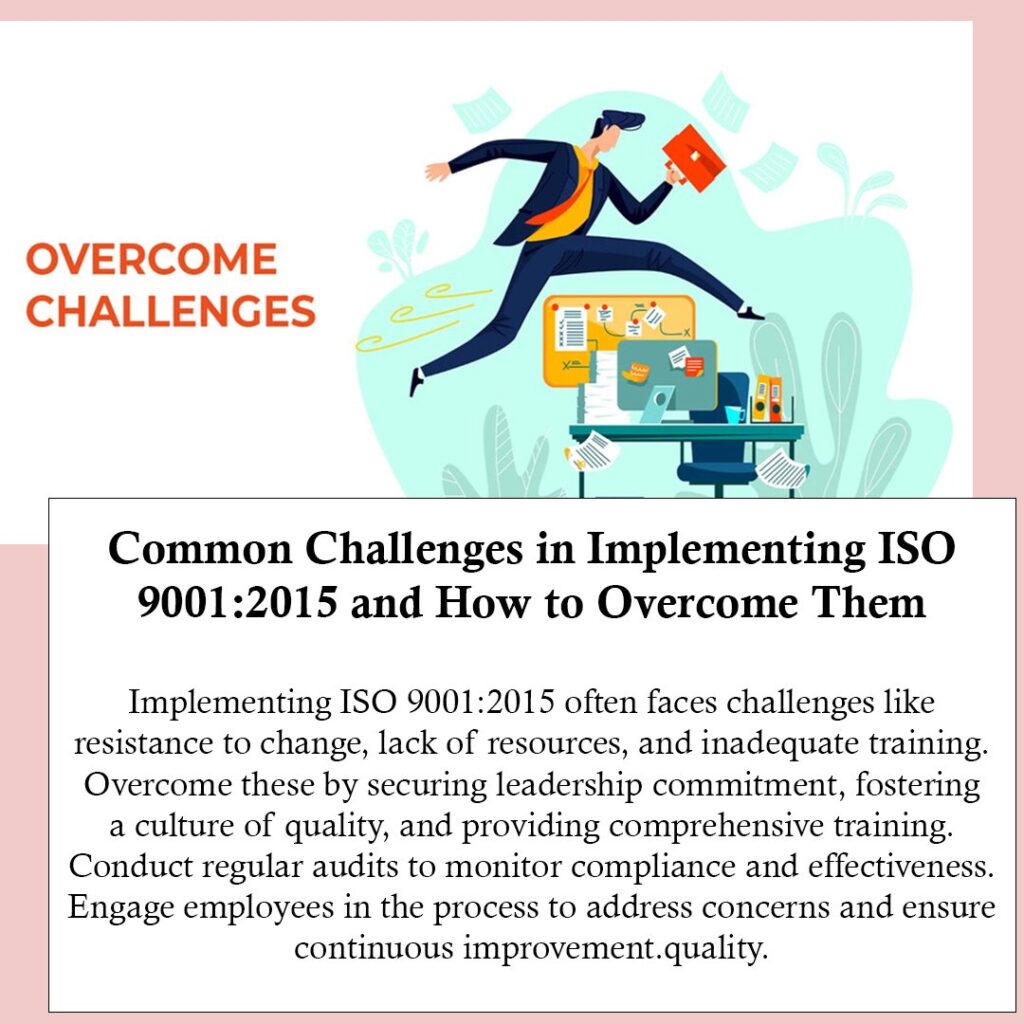Subtotal $0.00

Implementing ISO 9001:2015, while beneficial, can present several challenges for organizations. Overcoming these challenges requires careful planning, commitment from all levels of the organization, and a proactive approach to addressing potential obstacles. Here’s a comprehensive guide on navigating common challenges and achieving successful implementation of ISO 9001:2015.
1. Lack of Leadership Commitment
Challenge: Without strong support from top management, achieving buy-in and allocating necessary resources for QMS implementation becomes difficult.
Overcoming Strategy:
Top-Down Communication: Ensure leaders communicate the importance of ISO 9001:2015 and its benefits to the organization’s overall goals.
Allocate Resources: Dedicate sufficient resources, including time, budget, and personnel, to support implementation efforts.
Lead by Example: Demonstrate leadership commitment by actively participating in QMS activities and setting an example for others to follow.
2. Resistance to Change
Challenge: Employees may resist new procedures and changes to established workflows, viewing them as additional burdens rather than improvements.
Overcoming Strategy:
Change Management Plan: Develop a comprehensive change management plan that includes communication, training, and support mechanisms.
Employee Involvement: Involve employees in the implementation process, seeking their input and addressing concerns to foster ownership and acceptance.
Highlight Benefits: Clearly communicate how ISO 9001:2015 will benefit employees, such as improved processes, clearer roles, and career development opportunities.
3. Complex Documentation Requirements
Challenge: Organizations may struggle with the extensive documentation requirements of ISO 9001:2015, leading to confusion and inefficiencies.
Overcoming Strategy:
Simplify Documentation: Focus on documenting essential processes and procedures that add value to the QMS, avoiding excessive paperwork.
Standard Templates: Use standardized templates and formats for documentation to ensure consistency and facilitate understanding.
Training and Guidance: Provide training and guidance on documentation requirements, emphasizing clarity, relevance, and compliance with ISO standards.
4. Integration with Existing Systems
Challenge: Integrating ISO 9001:2015 with existing management systems or organizational processes can be complex and time-consuming.
Overcoming Strategy:
Gap Analysis: Conduct a thorough gap analysis to identify overlaps and areas where integration is needed.
Alignment with HLS: Utilize the High-Level Structure (HLS) to align ISO 9001:2015 with other management system standards, such as ISO 14001 or ISO 45001.
Cross-Functional Teams: Establish cross-functional teams to facilitate integration efforts and ensure all relevant departments are involved and aligned.
5. Maintaining Momentum and Engagement
Challenge: Sustaining momentum and engagement throughout the implementation process and beyond can be challenging, especially after initial enthusiasm wanes.
Overcoming Strategy:
Continuous Communication: Maintain regular communication about progress, milestones, and successes related to ISO 9001:2015 implementation.
Recognition and Rewards: Recognize and reward individuals and teams for their contributions to QMS implementation and achieving milestones.
Training and Development: Provide ongoing training and development opportunities to keep employees engaged and informed about QMS requirements and improvements.
6. Ensuring Effective Risk Management
Challenge: Implementing effective risk-based thinking as required by ISO 9001:2015 can be challenging, particularly in identifying and mitigating risks.
Overcoming Strategy:
Risk Assessment Tools: Utilize risk assessment tools and techniques, such as SWOT analysis, FMEA (Failure Mode and Effects Analysis), and scenario planning.
Continuous Monitoring: Implement regular reviews and updates of risk assessments to adapt to changing internal and external contexts.
Training and Awareness: Provide training on risk-based thinking principles and encourage a proactive approach to risk identification and management.
7. Addressing Non-Conformities
Challenge: Identifying and addressing non-conformities discovered during internal audits or other assessments can pose a challenge if not managed effectively.
Overcoming Strategy:
Root Cause Analysis: Conduct thorough root cause analysis to identify the underlying reasons for non-conformities and prevent recurrence.
Corrective Actions: Develop and implement corrective action plans that address identified non-conformities promptly and effectively.
Follow-Up and Verification: Monitor the implementation of corrective actions and verify their effectiveness through follow-up audits or reviews.
8. Implementing a Culture of Continuous Improvement
Challenge: Establishing and maintaining a culture of continuous improvement may face resistance or lack of sustained commitment.
Overcoming Strategy:
Leadership Support: Foster leadership support and commitment to continuous improvement initiatives, emphasizing their strategic importance.
Employee Empowerment: Empower employees at all levels to contribute ideas for improvement and participate in process enhancement activities.
Measurement and Feedback: Implement mechanisms to measure and provide feedback on improvements achieved through QMS implementation.
9. Resource Constraints
Challenge: Limited resources, including budget, time, and skilled personnel, can hinder effective implementation of ISO 9001:2015.
Overcoming Strategy:
Prioritization: Prioritize implementation activities based on their impact on QMS effectiveness and organizational goals.
Resource Allocation: Optimize resource allocation by leveraging internal expertise, outsourcing non-core activities, or seeking external support.
Phased Implementation: Implement ISO 9001:2015 in phases, focusing initially on critical processes and gradually expanding to other areas.
10. Preparing for Certification Audits
Challenge: The preparation and conduct of certification audits can be daunting, requiring thorough preparation and readiness.
Overcoming Strategy:
Mock Audits: Conduct mock audits to simulate the certification audit process and identify areas needing improvement.
Documentation Review: Ensure all required documentation is complete, accurate, and readily accessible to auditors.
Training and Readiness: Train personnel involved in the audit process to understand their roles and responsibilities during the audit.
Conclusion
Successfully implementing ISO 9001:2015 requires overcoming various challenges that organizations may encounter along the way. By addressing these challenges with proactive strategies, including leadership commitment, effective change management, streamlined documentation, and a culture of continuous improvement, organizations can navigate the implementation process effectively. Ultimately, overcoming these challenges not only facilitates ISO 9001:2015 certification but also enhances organizational resilience, efficiency, and customer satisfaction through a robust Quality Management System.